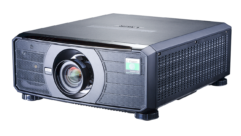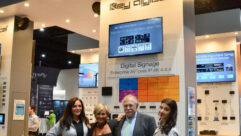Digital Light Processing:Behind The Hoopla
Feb 1, 1998 12:00 PM,
Peter H. Putman
Of all the current large-screen display technologies being peddled today,none has gotten more press coverage and “buzz” than Texas Instruments’Digital Light Processing , or DLP as it is commonly known. Full-pageadvertisements in leading business magazines have trumpeted the superiorimage quality of this all-digital system. Industry publications have waxedpoetic about DLP being the only true digital imaging process on the market.Even TI officials have jumped on the bandwagon, making claims about theimminent doom of CRT-based imaging systems as DLP light engines take theirplace.
If we were to believe everything we have heard to date about digital lightprocessing, we should be dumping 3-gun CRT projectors in dumpsters andtossing out our LCD projectors with yesterday’s newspapers. But that isn’thappening…yet. Maybe this would be a good time to cut through some of thehype and take a closer look at DLP.
THE MIRROR HAS MANY FACESAt the heart of a digital light processing projector is TI’s patentedDigital MicroMirror (DMD) device, a small RAM chip with an array of mirrorsmounted on its surface. Each of these tiny mirrors tilts in response tovarying electrical charges on the mirror’s mounting substrate. Depending onthe degree of tilt, individual mirrors reflect a greater or lesser amountof light from the projection lamp.
Because the degree of reflection varies from 100% white to black – and allsteps in between – a wide grayscale can be created. Using thousands ofmirrors, a grayscale image starts to appear, resembling the individual dotsin a screened photograph. Move those mirrors fast enough so that a newpicture can be refreshed 60 times per second, and you can now reproducefull-motion black and white video.
The last step is to add color, accomplished with either color wheels ordichroic mirrors and combining prisms. Throw in a projection lens and somesignal processing and you’ve got a digital light projector, or DLPprojection monitor. Other than the fact that DLP is a reflectivetechnology, it sounds an awful lot like LCD projection in many ways -doesn’t it?
That’s what many dealers, designers, installers and end users haveconcluded. Since INFOCOMM ’95 in Dallas, we’ve had plenty of opportunitiesto compare the image quality of DLP versus LCD. Back then, the brightnessand picture quality of the first DLP projector (nView’s Diamond D-400)surpassed most of the desktop 640 x 480 and 800 x 600 products on themarket. Today it’s a different story, as portable and desktop 800 x 600 andeven 1024 x 768 polysilicon LCD projectors have pushed DLP projection tothe back of the line in for all but high-end applications.
Page 2 DLP Hoopla
THE DOWNSIDEThere are two problems that have impeded the growth of DLP technology. Thefirst problem involves color imaging: Because of the size of the originalDLP light engine, it was impossible to adopt a three-chip dichroic colorsystem and keep the size and weight of the projector small enough to appealto the portable and desktop projection market segment. Instead, a singleDMD with a color wheel synchronized to mirror movements was employed. (Thiscolor wheel is still used in the new In Focus Lite Pro 420 and DavisPowerLite ultraportable projectors.)
The quality of color obtained from the wheel is not nearly as good as thatfrom a dichroic filter arrangement, especially when it comes to colorsaturation levels. Not only that, there is a noticeable strobing effectfrom the color wheel when you blink your eyes, resulting in a rainbow- likeeffect on otherwise white or gray areas of the image.
The second problem is Texas Instruments’ inability to ship 1024 x 768 DMDdevices to projector and monitor manufacturers, a serious setback in theadoption of DLP for higher-resolution workstation and graphicsapplications. These market segments want true pixel-for-pixel reproductionin their displays and prefer not to scale resolutions down to fit smallerpanels. The imaging devices used in DLP projectors available now are thesame ones that were used two years ago, and offer a maximum nativeresolution of 848 pixels by 600 pixels. (In that same two-year period, theLCD projector market has added 800 x 600, 832 x 624, 1024 x 768 and even1280 x 1024 amorphous and polysilicon imaging panels.)
THE UPSIDETo date, DLP has been less than successful in its battle with LCDtechnology in the under $10,000 segment. However, TI has done much betterin the high-end light valve product category. Here, the size and weight of projectors are not asmuch an issue as is their light output and projection lens options. All ofthe light valve DLP projectors have adopted the three-chip imaging systemwith dichroic filters and prisms, marrying them to metal halide and xenonprojection lamps.
Although DLP light valve projectors are also limited to 848 x 600resolution, they are more than a match for LCD light valves in terms ofimage quality. In fact, the xenon-lamped DLP projectors tend to produce farbetter colorimetry than metal halide-lamped LCD projectors. The best imagesI’ve seen have been produced by Digital Projection’s Power 4dv and 5dv,with Sony’s VPD- S1800U, and Electrohome’s Vista Pro series close behind.The only comparable product for video image quality would be Hughes-JVC’sCRT-based Image Light Amplifier .
For multimedia applications, these light valve DLP projectors have superiorvideo signal processing than lower-priced desktop models, resulting incleaner, sharper pictures with less noise and artifacts. It’s a realcontrast to the full-frame image scaling used in desktop DLP designs, whichfrequently results in blocky, dithered video with noticeable pixelstructures.
Page 3 DLP Hoopla
DIGITAL VS. ANALOGAs for DLP being the only true digital imaging system for large-screendisplays, there is a bit of truth to that statement. While both LCD and DLPdisplay panels use digital addressing to activate individualmirrors/pixels, both must convert an analog signal to do so. In theory, theDMD could handle digital modulation directly from a variety of programsources, if the appropriate digital “handshake” existed.
If you want to split hairs, the true digital difference with respect to aDLP projector is that its DMD does not respond in any analog fashion to theeffects of light and heat, and to a lesser extent, vibration. In contrast,LCDs can be and are affected by intense light and heat, causing “drift”which affects their switching times and light-shuttering ability. What’smore, the response of the individual liquid crystals in an LCD pixel isalways a linear (analog) response to the voltages present at theirswitching transistors.
If anything, DMD devices have an edge over LCDs in their greater efficiencyat processing light. Depending on the type of LCD used, 80% to 95% of thelight energy from the projection lamp is absorbed and never makes it to thescreen. DMDs do considerably better, losing about 40% of the projectedlight with monochrome images. However, add a color wheels and more light isabsorbed.
LEVELING THE FIELDIf you wanna play with the big boys, you gotta have the right equipment.That’s exactly the case with DLP technology, which has a ways to go beforeit can achieve parity with other flat-screen projectors. Several LCDmanufacturers showed desktop and fixed-mount 1024 x 768 polysiliconprojectors at this year’s COMDEX show, all with CRT-style composite andcomponent inputs. Add to this the half a dozen other XGA models that arealready shipping since INFOCOMM ’97, and you can see why TI is under thegun to ship XGA DMDs.
The folks in Dallas also can’t afford to wait too long to follow up withDMDs sporting resolutions of 1200 or more pixels. JVC has already shown anew 28 pound workstation and graphics projector, featuring a .9″ 1365 x1024 pixel ILA engine and 250 watt xenon lamp and offering the fullboardroom-style connector complement. Barco unveiled the BarcoReality 9200LC at INFOCOMM, and it uses amorphous 1280 x 1024 panels with dichroiccolor.
One last development that will help tremendously is TI’s decision to haveprojector manufacturers design their own light engine components. Thiscould result in a smaller 3-chip dichroic array, which could competehead-to-head with the desktop and fixed-mount XGA LCD projectors and startmaking a serious run at the traditional 7″, 8″, and 9″ three gun CRTprojector stronghold.
PP 12/10/97Revised 1/23/98Ver 1.0
–simple boundary–










